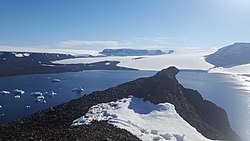Vega Island
| Vega Island | |
 Vega Island | |
|---|---|
| Location | |
| Location: | 63°49’59"S, 57°21’58"W |
| Data | |
| Population: | Uninhabited |
Vega Island is a small island to the north-west of James Ross Island, in the James Ross Island Group lying just to the west of the northernmost tip of Graham Land in the British Antarctic Territory. It is separated from James Ross Island by Herbert Sound.
The island was named by Otto Nordenskjold, leader of the Swedish Antarctic Expedition of 1901-04 in honour of the Vega, the ship which made the first voyage through the Northeast Passage, in 1878-79.
Vega Island is an important site for palaeontology. The region is extremely rich in terrestrial and marine fossils which span the boundary of the Cretaceous and Tertiary periods, covering the point in time when dinosaurs became extinct. Fossils found on the island include hadrosaurs, plesiosaurs, and mosasaurs.
Exploration
Vega lies on the south side of the entrance to the Prince Gustav Channel lying against the Trinity Peninsula. It is separated from James Ross Island to the south-east by Herbert Sound.
The island was roughly charted as part of the larger island by James Ross on 6 January 1843 and surveyed by the Swedish Antarctic Expedition in October 1903, which discovered that it is an island: the expediaiton leader, Otto Nordenskjöld, named the island Vega Ön after the Swedish ship Vega used by Baron A E Nordenskiöld (Otto's uncle) in making the first voyage through the Northeast Passage in 1878-79.
The island was resurveyed by the Falkland Islands Dependencies Survey from "Hope Bay" in November-December 1945 and was further surveyed by the Falkland Islands Dependencies Survey in 1960-61.
Geography
The island is a rare volcano type called a moberg, or tuya, which was formed by a three-stage eruption sequence below an ice cap. Stage one was a subglacial hyaloclastic eruption, which shattered the lava into glass, ash, and sand which has since weathered to yellow palagonite layers. The second phase was a lava eruption into a meltwater glacial lake contained in the ice cap, which resulted in volcanic breccia and basalt pillow lava. The final phase was subaerial basalt lava flows on top of the previous volcanic deposits after the lake drained or boiled away. The basalt flows forma cap rock along the northwest shore, which forms an impermeable layer that results in about sixty waterfalls on warm days.[1]
Outside links
- Antarctic Researchers to Discuss Difficult Recovery of Unique Juvenile Plesiosaur Fossil, from the National Science Foundation, December 6, 2006
References
- Gazetteer and Map of The British Antarctic Territory: Vega Island
- ↑ Joseph Holliday, Geology Professor, El Camino College
- "New Dinosaur Finds in Antarctica Paint Fuller Picture of Past Ecosystem". National Science Foundation. February 6, 1998. https://www.nsf.gov/news/news_summ.jsp?cntn_id=102864&org=olpa&from=news.